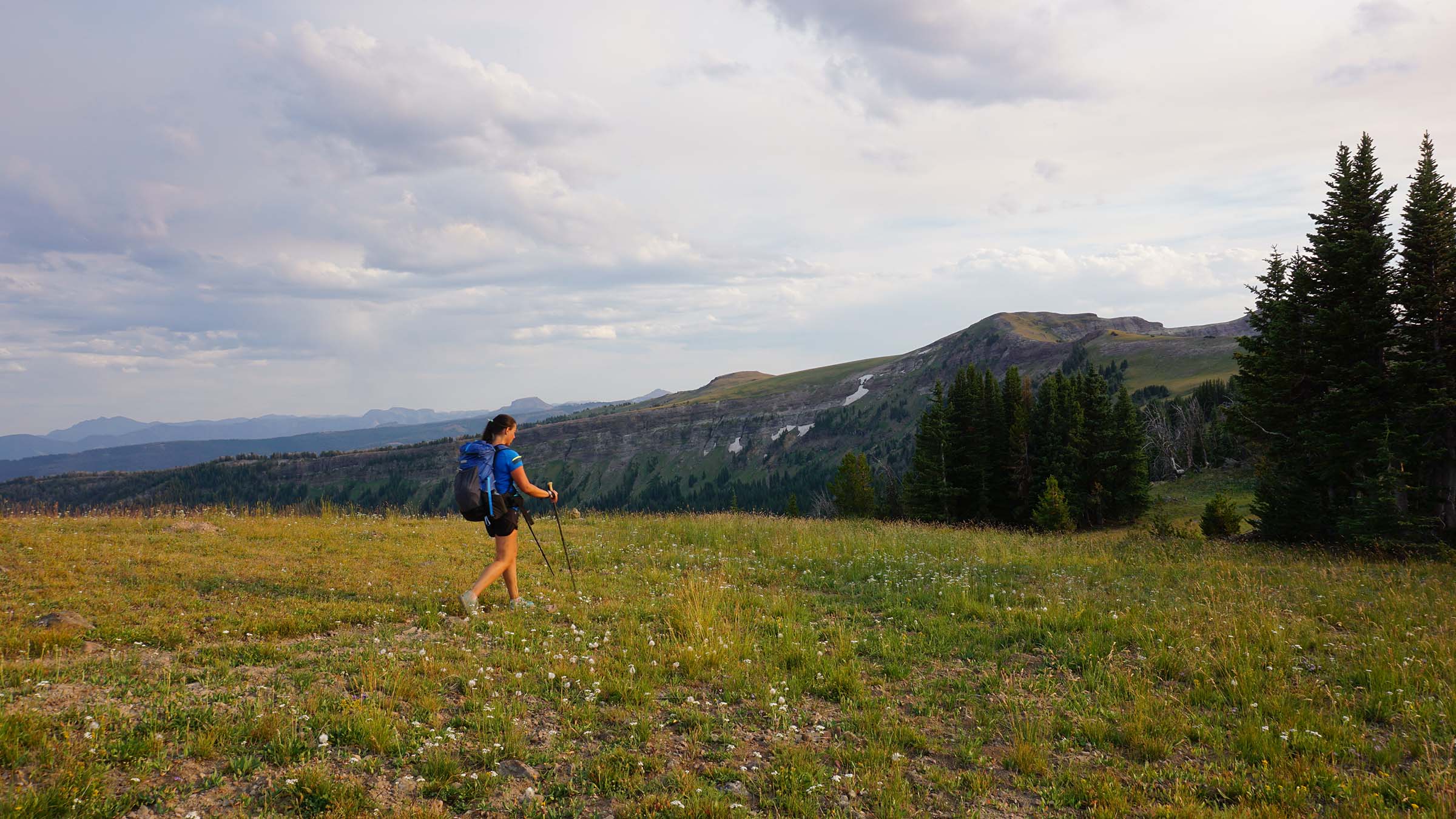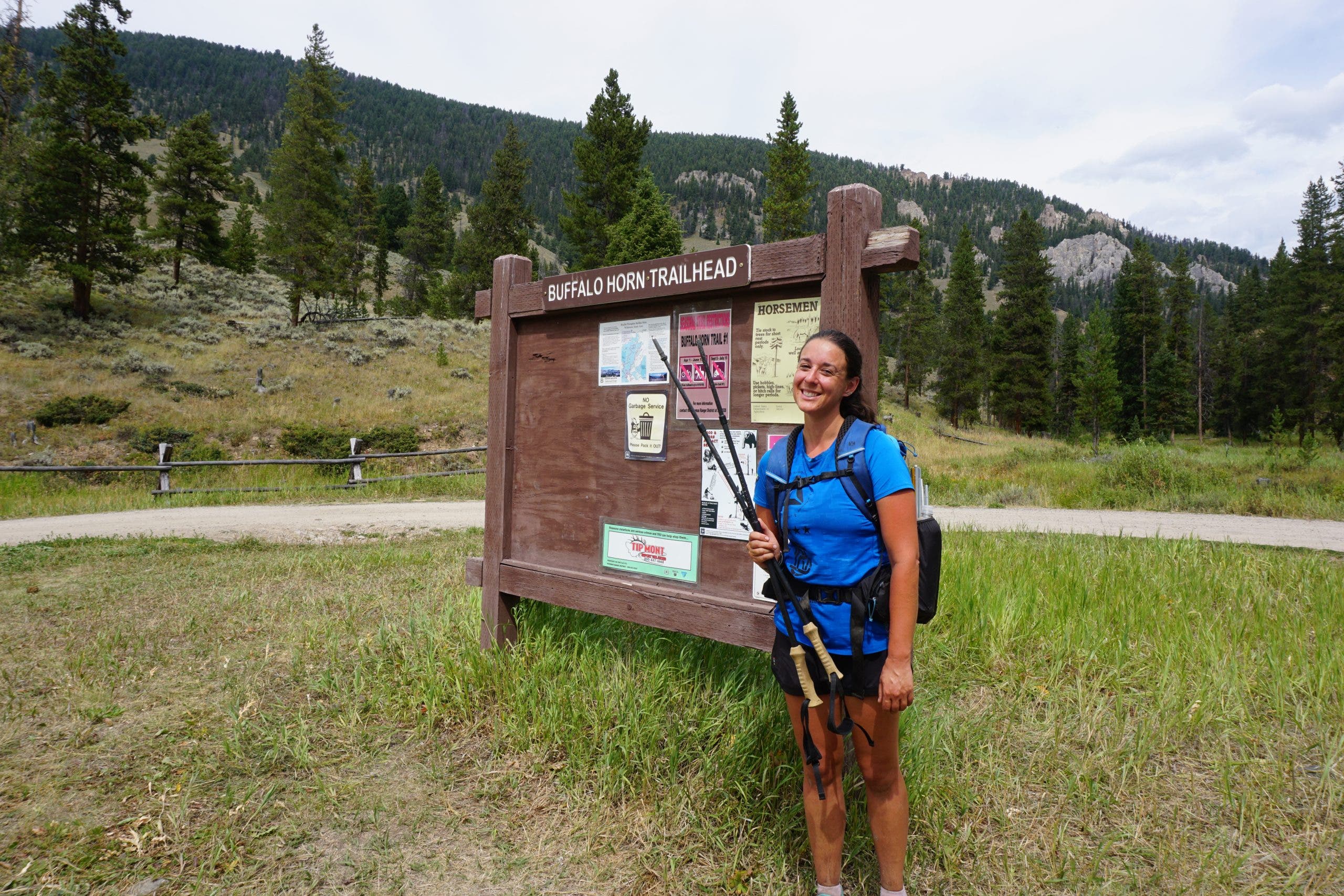Going Ultralight? Make Sure Your Gear Can Survive the Trip.

The author with her doomed poles. (Photo: Courtesy of Maggie Slepian)
Hiking isn’t just a hobby—it’s a lifestyle. Maggie Slepian tackles the hiking life—and all of the joys, problems, arguments, and weird quirks that go along with it—in her column.
When I caught up to my partner at the top of a steep climb on Montana’s Gallatin Crest Trail, I felt accomplished. The trail was faint, and I was breathing hard at the top of the climb, leaning on my poles. When I straightened up, though, Jeff looked at the pole in my left hand.
“Are you missing a chunk of that pole?” he asked. I looked down. Sure enough, the bottom several inches had sheared off. The carbon fiber had snapped cleanly, and the open end was packed with dirt. I hadn’t noticed, but then again, I’d been too busy wheezing up the peak.
I had no idea where the pole could have broken in the last few miles. I hadn’t stumbled, caught it on anything, or heard it break.
“That’s a carbon fiber pole for you,” Jeff said. I adjusted the broken pole so it was the same height as my intact one, and we moved along.
That was the first carbon fiber trekking pole I broke last season, but it wouldn’t be the last. I loved the low weight and flex of these poles, and refused to acknowledge the pattern at first. But after I went on to snap four more poles, I gave up and bought a pair of Ozark Trail aluminum poles from Walmart the day before a desert backpacking trip.

In the long-distance backpacking world, “intended use” directly relates to durability. We need our gear to last for the duration of a thru-hike, preferably more than one. Sometimes that thru-hike is a 70-mile trek, sometimes it’s 500 miles over the course of a month, and sometimes it’s more than 2,000 miles up the length of the country.
It’s not just poles that have let me down. A few seasons before, I was testing the Big Agnes Copper Spur Platinum when I caught the fly on a twig. Without thinking, I flicked the 7-denier ripstop nylon to release it from the twig, ripping a 12-inch gash in the material. I’d been using a heftier (and more durable) version of this tent prior to this test model, and I stared in disbelief at the jagged tear. That fall, I tested an ultralight version of a popular sleeping pad, only to have a seam fail in the middle of a trip.
People might question whether I’m hard on gear, but I don’t think I’m anything out of the ordinary. I still have fully functional items from my 2015 AT thru-hike—my AT backpack, puffy coat, and shelter are still in rotation—but I also managed to break five trekking poles in one season. I’m naturally more cautious with lighter equipment, but I do get frustrated with having to baby my backcountry gear. The allure of lower pack weight and streamlined gear is hard to resist, which is why I’m willing to give these new items test runs despite a string of on-trail breakages.
The further into ultralight gear manufacturers delve, the more durability seems to go out the window. In 2019, Big Agnes released DCF models of their popular Fly Creek and Tiger Wall tents. DCF is a waterproof material with incredible strength-to-weight ratio, beloved by cottage-industry manufacturers and the ultralight community. It was a valiant effort—it reduced weight without losing the design that makes these tents so livable—but it backfired, with translucent rain flies that barely stretched over the poles, plus fragile construction. And while DCF is stronger than other materials, the lower weight they used meant that some hard-hiking testers even put tears in that. They also retailed for around $1,000 each. Naturally for that price, reviews were mixed.
It’s one thing to replace broken gear in the middle of a season, but it’s quite another to snap a pole, tear a rain fly, or pop a sleeping pad in the middle of a thru-hike. Broken gear during a thru-hike typically forces you to hike a good distance with the busted equipment, then try to repair or replace it in town. If replacing in town isn’t possible, you’re stuck ordering gear and having it shipped to town, or trying to time the delivery for your next town stop. It’s a logistical hassle, and a lot of on-trail gear failures could be avoided if gear stopped just short of being too fragile for the trail. Those extra few ounces seem well worth it when you consider the money and time spent replacing on-trail breakages.
I’ve talked about preferring mid-weight gear, but this seems bigger than my own personal preferences. What is the point of building gear that isn’t durable enough to withstand standard backpacking trails and usage? I was told the Therm-a-Rest UberLite was plenty warm with a 2.3 R-value, but I’d have to be extra careful where I placed it at campsites thanks to the 15D Nylon face fabric. A friend of mine was on trail when she stumbled onto her Black Diamond carbon-fiber trekking pole, snapping it in half and tumbling onto a rock.
Even if you aren’t the type of backpacker who needs extra on-trail comfort, given the chance, most people want their gear to last a full season, or at least the duration of a long-distance trip. While weight might be one of the first metrics shoppers seek when comparing gear models, it’s not the be-all-end-all. The best gear out there strikes a balance between efficiency, durability, and weight savings. The lowest pack weight won’t do us much good if the gear doesn’t survive the trip.